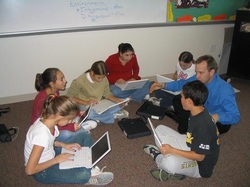
Garth Holman and his sixth grade social studies students
As the video below shows, the needs of students are continuously changing as technology and new literacies advance. Therefore, it is imperative that educators learn how to apply instructional technologies into their classroom. Whether a teacher has only one computer in their classroom, or all of the students have access to their own laptop, educators of today and tomorrow need to find a way to make this collaboration possible.
As found on the Teachers For Tomorrow website: "Collaboration, technology and personal reflection must be combined with new methodology and standards-driven curriculum to create a problem-based inquiry-learning environment. Our job is to create thinkers, leaders and problem solvers. As educators, our responsibility to stay ahead of the digital natives who enter our classrooms. Students must develop critical thinking, learning, and study skills that take them beyond the classroom. Creating a new learning environment will produce more intelligent people. More intelligent people can stimulate industry and innovation, drive the economy, and change the world. Only through hard work and risk-taking are such goals possible. The ends justify the means; but to accomplish such goals one must concentrate on the journey, not the destination."
I am keeping this blog to document my reflections on what I learn during my Instructional Technology Applications mastery course so that I can come back months later and relearn if necessary. I am a teacher of tomorrow; therefore, my instructional strategies should reflect the needs' of my students of tomorrow. This class will help me learn new technologies, generate creative instructional lessons, and make meaningful experiences for my middle school social studies and science students. Thanks Garth!
-Andrea
As found on the Teachers For Tomorrow website: "Collaboration, technology and personal reflection must be combined with new methodology and standards-driven curriculum to create a problem-based inquiry-learning environment. Our job is to create thinkers, leaders and problem solvers. As educators, our responsibility to stay ahead of the digital natives who enter our classrooms. Students must develop critical thinking, learning, and study skills that take them beyond the classroom. Creating a new learning environment will produce more intelligent people. More intelligent people can stimulate industry and innovation, drive the economy, and change the world. Only through hard work and risk-taking are such goals possible. The ends justify the means; but to accomplish such goals one must concentrate on the journey, not the destination."
I am keeping this blog to document my reflections on what I learn during my Instructional Technology Applications mastery course so that I can come back months later and relearn if necessary. I am a teacher of tomorrow; therefore, my instructional strategies should reflect the needs' of my students of tomorrow. This class will help me learn new technologies, generate creative instructional lessons, and make meaningful experiences for my middle school social studies and science students. Thanks Garth!
-Andrea